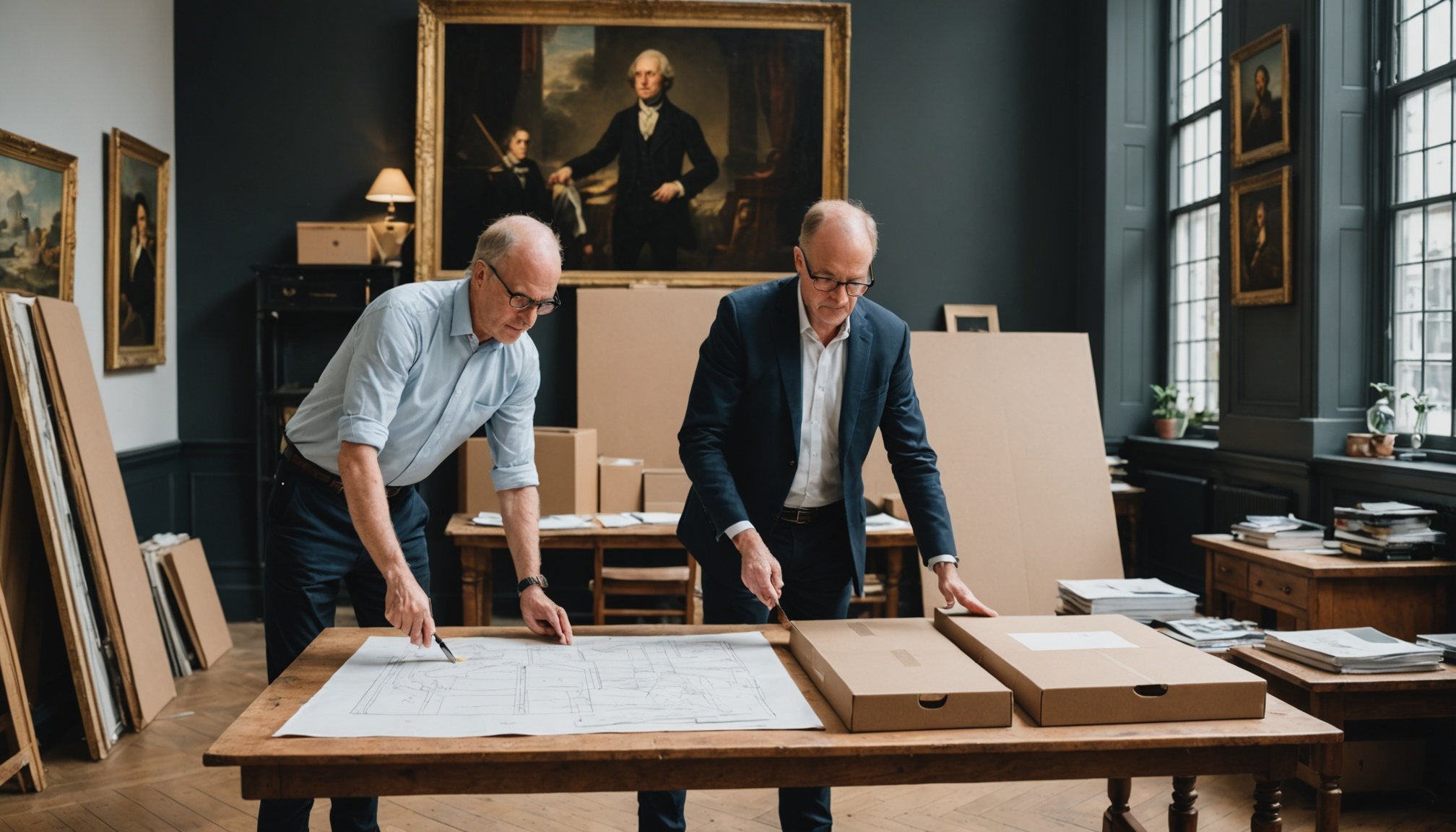Importance of Proper Packing for High-Value Art
Ensuring the secure transportation of high-value art is crucial to avoid damage and preserve its value. Art packing importance cannot be overstated as improper packing exposes art pieces to significant risks, including physical damage, exposure to harmful environmental conditions, and loss of irreplaceable value.
Understanding these risks is the first step toward prevention. Poor packing increases the likelihood of scratches, punctures, or complete destruction during transport, especially when artworks must withstand long journeys.
Also read : Essential Steps to Safeguard Your Privacy When Relocating in the UK
Employing professional packing techniques significantly mitigates these risks. Professional packers have the expertise to use materials and methods tailored for each specific art piece. They select appropriate cushioning, such as foam or bubble wrap, and design custom crates that provide a snug fit, effectively minimizing movement during transit. This level of specificity maintains the artwork’s integrity, even under less than ideal conditions.
Proper packing also facilitates the long-term preservation of art during transport by protecting against factors such as humidity changes or temperature fluctuations, which can accelerate deterioration. By ensuring these elements are controlled, artworks remain in their optimal state until they reach their destination, preserving history and cultural significance for future exhibitions and collections.
Also to see : Top Strategies to Effortlessly Sell Your Unwanted Furniture in the UK Before Moving
Essential Packing Techniques
Navigating the art of packing requires meticulous attention, particularly when handling valuable pieces. Employing the right packing techniques ensures art handling is done with care, facilitating its safe transport to the next destination.
Step-by-Step Packing for Paintings
For painting preservation, select the appropriate materials. Acid-free paper, corner protectors, and bubble wrap are essential. Large paintings demand a robust wooden crate, protecting against impact. Smaller works may suffice with sturdy cardboard boxes, but always wrap them securely. Layers of glassine paper prevent surface damage and static cling. To avert damage, use soft packing above and below the piece, minimizing movement. Ensure safe transport by labelling each package clearly as fragile and indicating correct handling instructions.
Packing Sculptures Safely
Sculptures, with their diverse shapes, present unique challenges. To secure them effectively, employ foam inserts or custom crates for stability. Choose non-abrasive packing materials and stabilize fragile elements by creating bespoke supports. It’s crucial to protect sculptural elements exposed or vulnerable during transit.
Other Art Forms and Their Unique Needs
Different art forms like textiles, ceramics, and glass have specific packing requirements. Textiles must be rolled rather than folded to prevent creasing. Ceramics benefit from cushioned layers to absorb shocks, while glass needs ample padding to withstand impacts. Keep in mind the effects of humidity and temperature on each medium, as these factors can compromise integrity. Adjust packaging accordingly to safeguard against environmental conditions.
Recommended Packing Materials
When it comes to safeguarding your artistic treasures, using the right art packing materials is paramount. Protection supplies such as bubble wrap and foam are often the first line of defence. Bubble wrap stands out for its cushioning properties, enveloping fragile surfaces to absorb shocks. Meanwhile, foam sheets offer additional padding, ensuring that no corner is left vulnerable during transit.
Understanding packing best practices guarantees the safety of your valuable pieces. Custom crating is vital for artworks of exceptional worth. This technique involves crafting a bespoke wooden box to fit the specific dimensions and shape of the artwork. This not only provides an exact-fit security but also minimises movement during shipping, thus reducing potential damage.
When sourcing quality packing materials in the UK, consider local suppliers who specialise in art packing materials. These suppliers often provide a range of protection supplies tailored to different types of artwork, from paintings and sculptures to delicate glassworks. Always ensure that the materials meet industry standards for strength and durability.
By investing in suitable packing best practices, you can be confident that your artworks will maintain their pristine condition, no matter their journey. The combination of high-quality materials and tailored solutions ensures that your pieces receive the best protection possible.
Transportation Logistics
Efficient art transportation logistics are crucial for ensuring that valuable works of art are moved securely. The process of moving art securely involves meticulous planning and consideration to prevent damage or loss.
Choosing the Right Transport Method
Selecting the appropriate transport method is essential for successfully moving precious items. It’s important to evaluate various vehicle types specifically designed for art transport. Professional movers who specialise in art relocations bring expertise, using tailored equipment and packaging to maintain the integrity of the artworks.
- Professional Movers: They offer comprehensive services to manage every aspect of the move, from packaging to delivery, ensuring the safe transport of artworks.
- DIY vs. Hiring Professionals: While some might consider handling the move themselves, hiring professionals minimises the risk of damage. DIY options require significant knowledge and resources, while professionals provide peace of mind with their experience and equipment.
Route Planning and Timing
Careful scheduling of art transport is imperative, considering both timing and route selection. The chosen path should minimise jolts and vibrations to safeguard delicate items.
- Determine Optimal Timing: Avoid moving during peak hours or in adverse weather conditions to reduce the risks involved.
- Consider Route Factors: The route should be evaluated for potential disruptions, ensuring the fastest and safest passage. Planning ahead leads to fewer unexpected delays and enhances the reliability of art transportation logistics.
Insurance Considerations
When it comes to safeguarding investments in art, obtaining the right art insurance is crucial, especially for high-value art. Whether you’re transporting artwork across town or internationally, having the proper insurance in place ensures peace of mind and financial protection against damages or loss.
Coverage Options
Various coverage options are available to secure your precious pieces. Transport insurance is essential, providing coverage for pieces in transit should they be lost, stolen, or damaged. Additionally, you might consider exhibition insurances if you’re showcasing art in a gallery or public space, protecting against specific risks associated with public display. Always verify the specific clauses about environmental damage, theft, or accidental damage, as these can vary significantly between providers.
Evaluating Insurance Providers
Choosing the right provider involves more than finding a reputable name. Ensure they have expertise in art insurance and offer customizable plans to fit your needs. Ask potential providers:
- What experience do you have with art insurance?
- Can you offer references from artists or collectors?
- What does a standard policy cover, and are there any exclusions?
Engaging with a knowledgeable provider will not only protect your investment but also offer valuable advice on maintaining the integrity of your collection. Make sure your decision factors in the comprehensive evaluation of coverage options and the art insurance provider’s reliability.
Addressing Common Challenges
Encountering art moving challenges can be daunting, but understanding common issues and effective problem-solving techniques can ease the experience. Whether dealing with unexpected delays or handling damage claims, proactive steps can make a significant difference.
Dealing with Unexpected Delays
Transport delays are sometimes inevitable. Preparing in advance for such scenarios can mitigate their impact. Ensure your artwork is protected during unforeseen events by utilizing high-quality packing materials and considering insurance options. Communication with movers is crucial; keep an open line of dialogue to remain informed about any scheduling changes and updates.
Handling Damage Claims
In the unfortunate event that damage occurs to your art, taking immediate action is vital. Begin by thoroughly documenting the condition of the art before and after the move. This documentation can include photographs and written descriptions, which are essential when navigating the claims process.
When a claim needs to be filed, understanding the necessary steps can streamline the process. Contact the moving company promptly, provide all documented evidence, and follow their specific claims procedures. Being well-organised and diligent can improve the likelihood of a favourable resolution. By effectively managing these potential challenges, you can ensure your art’s safe arrival at its new location.
Professional Services for High-Value Art Moving
When dealing with art moving professionals, finding the right partner is crucial for ensuring the safe transportation of high-value pieces. Identifying specialized art moving companies involves researching those that offer expert services tailored to these unique demands. Look for companies with a proven track record in handling fragile and high-value artworks, as they will be better equipped to ensure your pieces are transported safely.
The benefits of hiring professionals for high-value art are significant. First, these experts understand the intricacies involved in packing, transporting, and unpacking delicate items, reducing the risk of damage. Second, they provide the necessary insurance and security measures to protect your investment during the move.
When selecting a mover, several factors should be considered to ensure you choose a qualified professional. Evaluate their experience and reputation within the art community. Ask about their specialized packaging materials and techniques. Additionally, consider their ability to handle logistics, including customs procedures for international shipments, which can be complex.
In conclusion, engaging with expert services for transporting your art can save time and provide peace of mind. By carefully evaluating your options, you can select a mover that aligns best with your needs, ensuring your valuable pieces are well cared for throughout the moving process.











